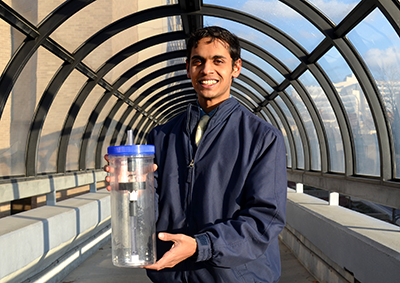Take it from Stephen John, a UMMS student whose infant respirator invention has already garnered recognition and some funding, and could soon be helping premature newborns breathe easier across the developing world.

John was an undergraduate engineering student on the hunt for a senior project when his pediatrician father posed a problem: the small hospital where he worked in Nepal couldn’t afford the type of dual-pressure ventilators often required to help very young babies breathe on their own. Common in western hospitals, traditional ventilators come with a high price tag that is often a barrier in developing countries, where the vast majority of neonatal deaths (in the first four weeks of life) occur.
“Respiratory issues are a leading cause of deaths in premature infants, and the ventilators are expensive,” said John. “But when you strip away all of the electronics – the bells and whistles – you’ve actually got a relatively simple mechanical engineering problem.”
He imagined an attachment that could transform a bubble CPAP machine, which delivers constant, single-pressure ventilation, into a dual-pressure ventilator. Bubble CPAPs date back to the early 1970s and have given way to newer ventilation technology in many western hospitals. But they are affordable and still in wide use elsewhere in the world. (The machines are used at UMHS.)
“These machines may have fallen somewhat out of favor, but the engineering concepts are sound,” said John. “You don’t want to automatically dismiss the engineering of the past, because you might be discarding some good principles.”
His vision was simple: a device with no electronic display, input keys, or alarms. It wouldn’t even require electricity, as bubble CPAPs can run on compressed air. The earliest prototypes were assembled in his kitchen from milk cartons, pipe cleaners, PVC pipe, and empty single-serving yogurt cups – junk, basically.
“It was about a year before we had a version that really worked well. There was lots of trial and error, but we figured it out,” said John, a second-year UMMS student who holds undergraduate engineering and biology degrees from Western Michigan University. “When I told some of my business school friends that we could make this thing for about one-hundredth the cost (of traditional ventilators) – or even far less – they didn’t believe it.”
John’s elegant solution, essentially an inverted cup-valve, is suspended in the water of the CPAP machine. The cup captures the discharged bubbles, becomes light, and floats toward the surface (higher pressure) before releasing the air and sinking back toward the bottom (lower pressure). Critical parameters like the high- and low-pressure settings and the number of cycles per minute can be independently adjusted. (Watch a video showing the device in action.)
Because there is only one moving part and no electronics, training is easy and maintenance is simpler still. And (MacGyver-eat-your-heart out!) John’s device costs about $25. Meanwhile, most stand-alone, dual-pressure infant ventilators in use today start at around $2,500, and can cost as much as $25,000.
The affordability, simplicity and ease of use make the invention a perfect fit for the developing world, which is where John’s passions are rooted. His parents are from India and, while born in the United States, he spent many of his formative years in Nepal. He continues to spend his summers there, volunteering alongside his father at Tansen Mission Hospital, in the western part of the country. (This past summer, John brought along a 3-D printer and taught the staff how to design custom parts – missing buttons, lost or broken dust covers – to repair broken equipment.) In the long-term, John plans to work overseas in a capacity that leverages both his engineering and medical training.
“I want to be working abroad and design my own equipment,” he said. “I feel that with engineering you can only do so much, and with medicine you can only do so much. Especially overseas, you really have to have both.”
His ventilator invention has earned several awards, including a $15,000 first prize in a national 2015 collegiate inventors competition. It also captured the attention of Respiratory Therapists without Borders; the non-profit has supported the project from the earliest stages and is helping to organize a limited patient trial early next year – at the same hospital where John’s dad works. If all goes well, more widespread trials will follow across several countries.
Not bad for a 22-year-old.
“It’s exciting to think about how far we’ve come from cutting up yogurt cups, but I have to remind myself that we haven’t actually saved any lives yet, and that’s the goal,” John said. “In the U.S., a device like this has cost-saving potential, which is great. But overseas, it becomes a life-saving device, and that’s the primary motivation.”
